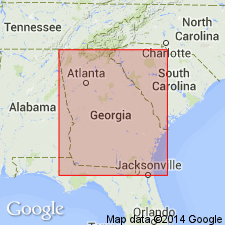
- Usage in publication:
-
- Corbin granite
- Modifications:
-
- Named
- Dominant lithology:
-
- Granite
- AAPG geologic province:
-
- Appalachian basin
Summary:
Corbin granite named for its development around Corbin, Bartow Co., northwestern GA. Chiefly massive, coarse-grained rock, with large porphyritic crystals of microcline in large groundmass of plagioclase feldspar, muscovite mica, and blue quartz. Some portions of rock have undergone considerable alteration, and have been converted into augen gneiss. Probably Archean.
Source: GNU records (USGS DDS-6; Reston GNULEX).
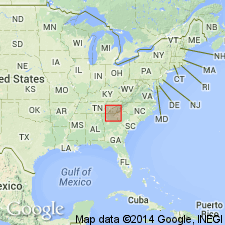
- Usage in publication:
-
- Corbin granite
- Modifications:
-
- Overview
- Areal extent
- AAPG geologic province:
-
- Appalachian basin
Summary:
Corbin granite is exposed southwest of Salem Church granite and just east of the Cartersville overthrust, along which the Corbin granite is sheared to an augen gneiss and some layers to a seritic or graphitic schist. Basal beds of Pine Log conglomerate rest on that granite which is brought up in an anticline. Salem Church granite resembles phases of Corbin granite and because of this similarity, has been called Corbin granite (Furcron and Teague, 1945, Georgia Geol. Survey Bull. 51). The Corbin is here considered a hybrid rock and regarded as part of an injection complex that occurs below Hurricane graywacke (new).
Source: GNU records (USGS DDS-6; Reston GNULEX).
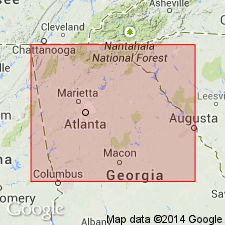
- Usage in publication:
-
- Corbin granite
- Modifications:
-
- Areal extent
- AAPG geologic province:
-
- Appalachian basin
Summary:
Described as strongly gneissic aggregate of feldspar, smoky-blue quartz, biotite, augite, and garnet. Intrusive into Talladega series.
Source: GNU records (USGS DDS-6; Reston GNULEX).
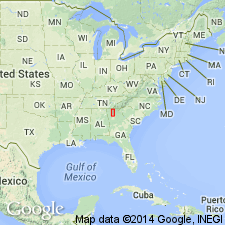
- Usage in publication:
-
- Corbin Gneiss Complex
- Modifications:
-
- Revised
- AAPG geologic province:
-
- Appalachian basin
Summary:
Unit is here formally redefined as Corbin Gneiss Complex. Term was informally introduced by McConnell and Costello (1980) to describe rocks previously defined as Corbin granite and Salem Church granite. Represents an intricate association of orthogneisses and paragneisses. Is basement complex underlying Pinelog Formation. Similar to Fort Mountain Gneiss in the Fort Mountain area. Age is Precambrian (Grenville).
Source: GNU records (USGS DDS-6; Reston GNULEX).
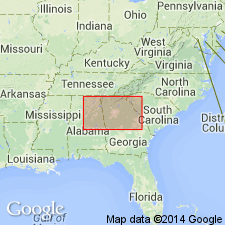
- Usage in publication:
-
- Corbin Gneiss*
- Modifications:
-
- Revised
- AAPG geologic province:
-
- Appalachian basin
Summary:
Revised as Corbin Gneiss and assigned to the Allatoona Complex in the Bill Arp thrust sheet in the western flank of the Murphy synclinorium in northern GA. It includes the metaplutonic rocks in the basement complex east and northeast of Cartersville. Rocks formerly assigned to the Salem Church Gneiss and Fort Mountain Gneiss, both here abandoned, are lithologically identical to the Corbin and are assigned to it. It is composed of coarsely megacrystic granitic gneiss. Metasedimentary schists of the Red Top Mountain Schist occur as xenoliths and roof pendants in the Corbin Gneiss and also form its country rock. Unconformably underlies the Pinelog Formation which contains pebbles and cobbles of Corbin Gneiss. Age is Middle Proterozoic.
Source: GNU records (USGS DDS-6; Reston GNULEX).
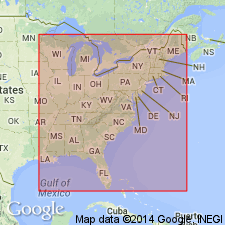
- Usage in publication:
-
- Corbin Gneiss*
- Modifications:
-
- Geochronologic dating
- AAPG geologic province:
-
- Piedmont-Blue Ridge province
Summary:
Corbin Gneiss has Rb-Sr whole-rock isochron age of 1003 +/-5 Ma (Odom, IN Rankin and others, 1983).
Source: GNU records (USGS DDS-6; Reston GNULEX).
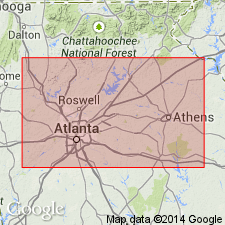
- Usage in publication:
-
- Corbin Metagranite*
- Modifications:
-
- Revised
- Age modified
- Geochronologic dating
- AAPG geologic province:
-
- Appalachian basin
Summary:
Revised as Corbin Metagranite of Allatoona Complex. Detailed mapping of Allatoona Dam 7.5-min quad shows lithologic variability in massive phase of the Corbin due to variable shearing and mylonitization and that in many areas massive phase of Corbin has no perceptible foliation, is only very rarely layered, and therefore is rarely a gneiss and best described as a metagranite. Corbin Metagranite also includes 1) small outcrops of finer grained, mica poor quartz-feldspar rock that generally lacks foliation, 2) rocks intermediate between mica-poor rocks and massive megacrystic Corbin, and 3) a biotite-rich, sheared phase ranging from mylonite gneiss to mylonite schist/phyllonite. Age is changed to Middle(?) to Late Proterozoic based on 1) Middle Proterozoic U-Pb zircon ages reported by Odom and others (1973), 2) data from Dallmeyer (1975) for undisturbed 40Ar/39Ar release spectra with total-gas ages of 735 and 732 Ma, both +/-15 Ma, and 3) a discordant U-Pb age of a bulk sample of zircon of 1.1 to 1 Ga.
Source: GNU records (USGS DDS-6; Reston GNULEX).
For more information, please contact Nancy Stamm, Geologic Names Committee Secretary.
Asterisk (*) indicates published by U.S. Geological Survey authors.
"No current usage" (†) implies that a name has been abandoned or has fallen into disuse. Former usage and, if known, replacement name given in parentheses ( ).
Slash (/) indicates name conflicts with nomenclatural guidelines (CSN, 1933; ACSN, 1961, 1970; NACSN, 1983, 2005, 2021). May be explained within brackets ([ ]).

